Best AI Productivity Tools for Students and Researchers
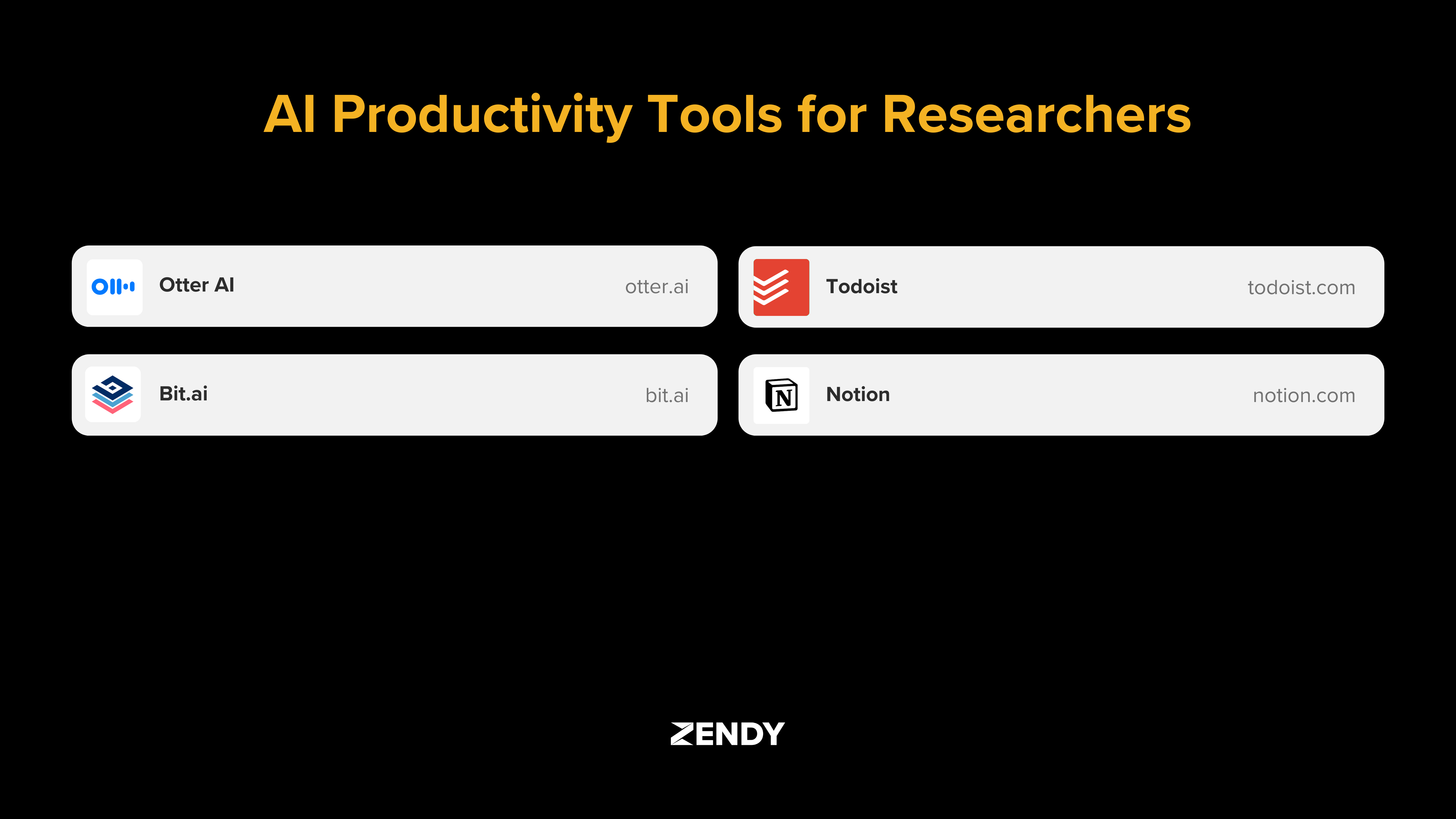
AI productivity tools are digital platforms that use artificial intelligence to help researchers work more efficiently. Unlike traditional software, these tools use algorithms and machine learning to automate routine tasks, process large amounts of information, and generate insights.
Traditional productivity apps rely on manual input. AI-powered tools can learn from user habits, interpret natural language, and offer smart suggestions. For researchers, this means tasks like transcription, organisation, and project management happen faster with less effort.
The benefits of AI-powered productivity tools for students to enhance academic workflows include:
- Time efficiency: Automated transcription and summarisation
- Accuracy: Reduced manual errors in data processing
- Organisation: Smart categorisation of notes, tasks, and references
- Collaboration: Real-time sharing and editing of documents and projects
Quick comparison of Otter.AI, Bit.ai, Notion, and Todoist
AI productivity tools offer different features for research, writing, collaboration, and task management. Understanding which tool handles which function helps you choose the right combination.
| Tool | Transcription | Document Collaboration | Task Management | Knowledge Organization |
| Otter.AI | Yes | Limited (shared notes) | No | Keyword search, highlights |
| Bit.ai | No | Yes | Limited | Centralized workspace |
| Notion | No | Yes | Yes | Databases, linked notes |
| Todoist | No | Limited (shared tasks) | Yes | Project lists |
Each tool provides a free version, making them accessible to students and researchers who want to try basic features. Advanced features for collaboration, automation, and AI-powered suggestions are available in paid plans.
Best-fit scenarios for each tool:
- Otter.AI: Recording and transcribing interviews, lectures, or meetings
- Bit.ai: Collaborative writing, team documentation, and organising research materials
- Notion: Managing literature reviews, creating structured research databases, and planning projects
- Todoist: Tracking deadlines, managing tasks for long-term research projects
Where Otter.AI fits in the research workflow
Otter.AI uses speech-to-text technology to convert spoken words into written text. In research, it captures and documents conversations, meetings, interviews, and lectures automatically. The tool processes audio in real time and generates a digital transcript that can be reviewed and edited after the session.
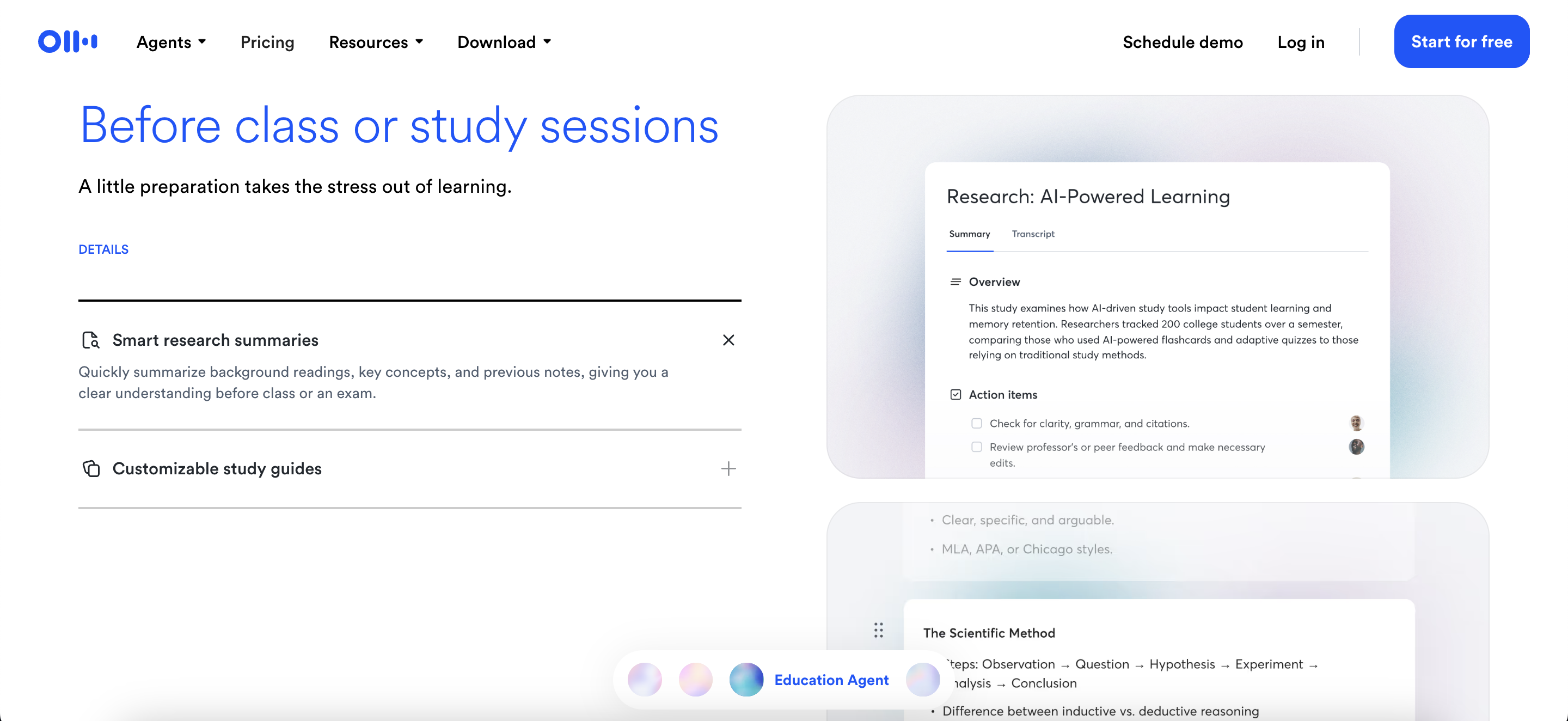
The platform provides real-time transcription, converting speech into text as it happens. This works during interviews or classroom lectures, recording and transcribing spoken content simultaneously. The tool identifies and labels different speakers, helping track who is talking in group settings. Transcription accuracy depends on audio quality, background noise, and speaker clarity.
Once a transcript is created, it becomes a searchable text document. You can search for specific phrases, topics, or keywords within the transcript to locate information quickly. The platform highlights keywords or important sections, making it easier to analyse large volumes of qualitative data. This searchable database supports reviewing, coding, and referencing spoken information during research analysis.
How Bit.ai streamlines collaborative writing
Bit.ai is a document collaboration platform that uses AI to help research teams and co-authors work together on academic projects. It creates a single online space for groups to create, edit, and organise research documents.
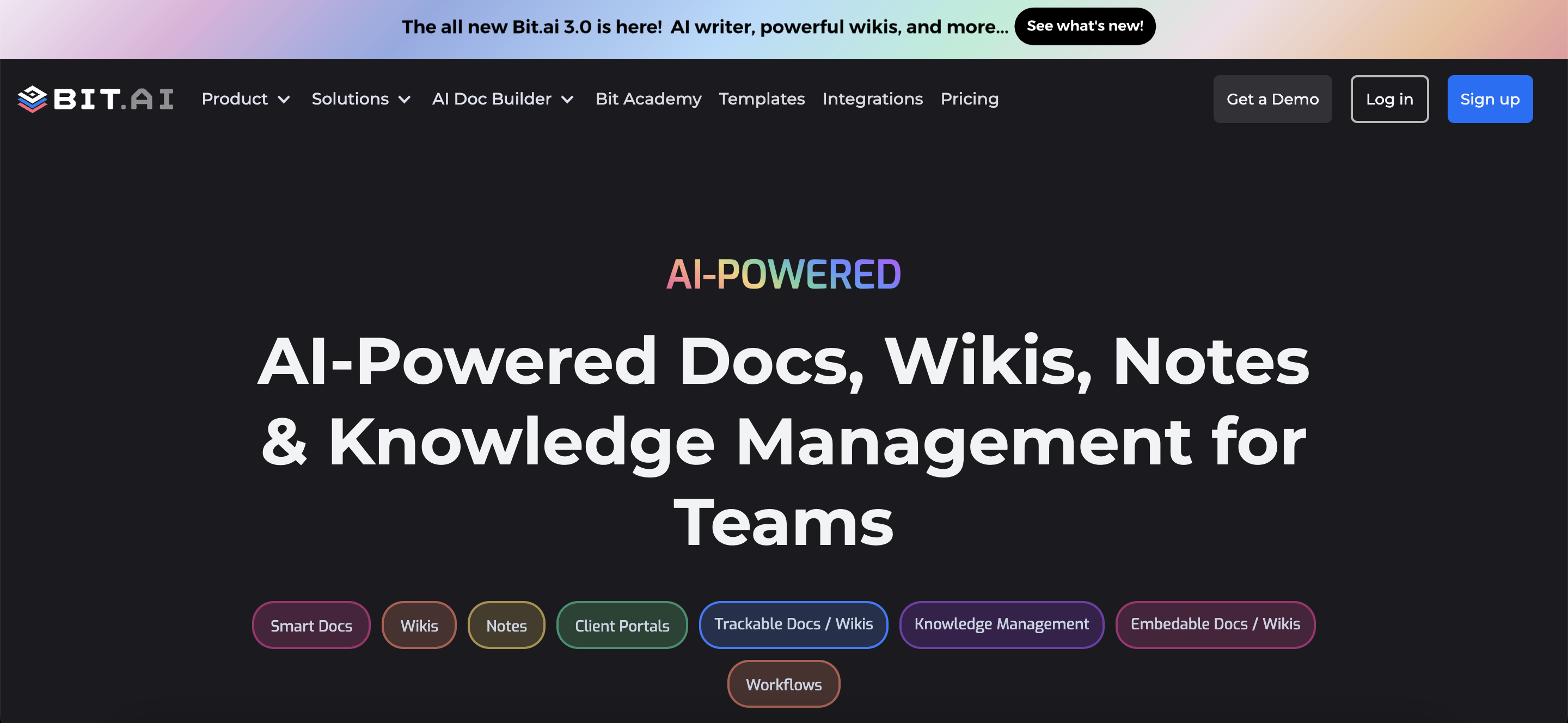
The platform allows users to embed rich media such as images, videos, and interactive charts directly into documents. So as a team, you can edit the same document simultaneously, and changes appear instantly for everyone. AI features suggest content improvements, recommend citations, and help organise ideas as users write.
Bit.ai provides a centralised workspace where teams can store and arrange research materials, references, and notes. Users create folders for different projects or topics, making it easier to locate specific files and information. All team members can access shared resources and contribute to the collective knowledge base.
Managing projects and deadlines with Todoist AI
Todoist AI handles project management for research workflows that include multiple deadlines, contributors, and project phases. The platform helps with planning and tracking ongoing or long-term academic projects, such as group research papers, lab work, or thesis development.
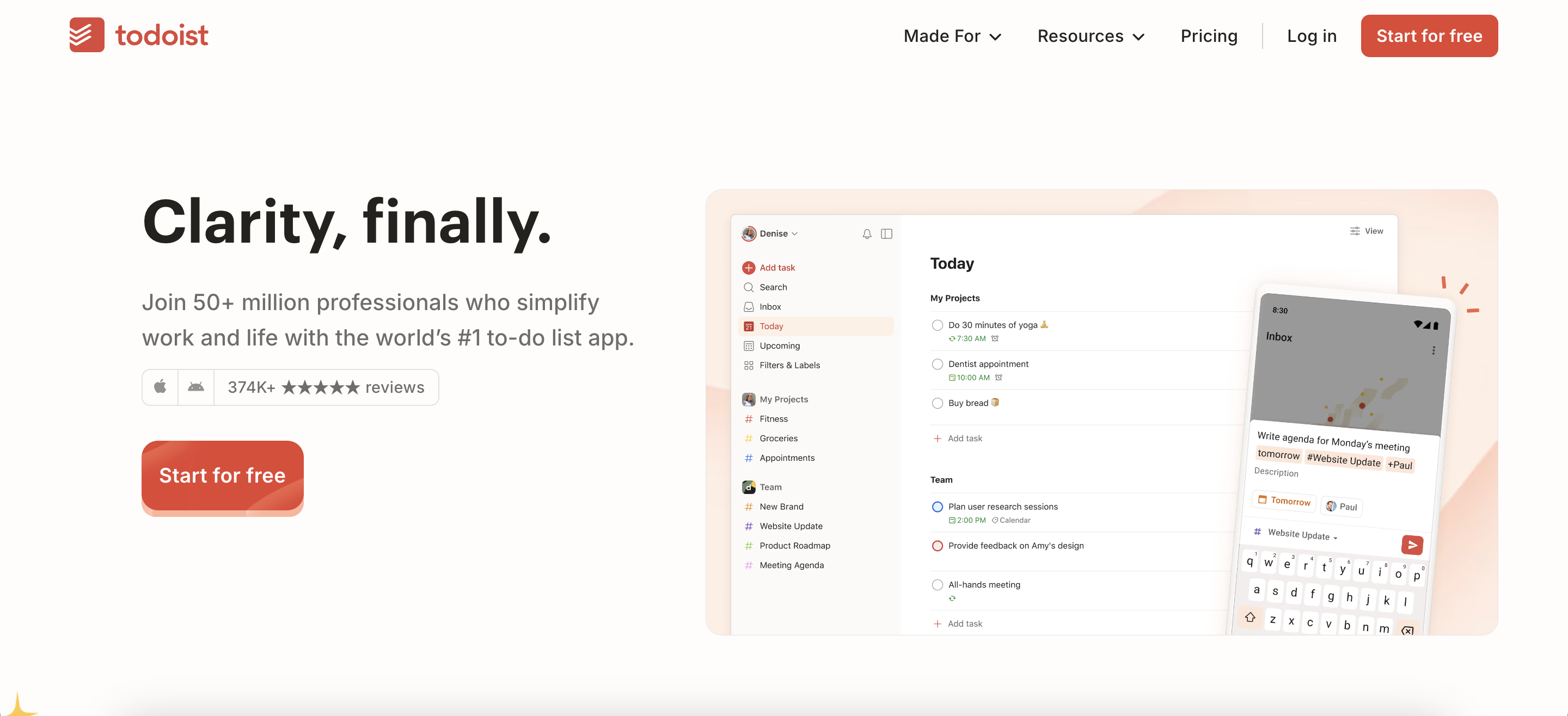
The AI task management tools use AI to rank tasks according to their deadlines, dependencies, and importance within each stage of a research project. The system analyses which tasks are most urgent, identifies which activities rely on others being completed first, and adjusts priorities as new information is added or project phases change.
Smart scheduling features include intelligent allocation of time blocks for each task based on deadlines and workload. The platform generates automated reminders for important milestones, such as draft submissions, experiment dates, or meetings. When timeline changes occur, Todoist AI updates the schedule and sends notifications to keep team members aware of upcoming deadlines.
Organising knowledge bases in Notion AI
Notion AI combines note-taking, databases, and task management in one platform. Researchers use Notion AI to organise articles, research notes, and project documents in a single, structured environment. This tool supports literature management and research organisation for individuals and teams.
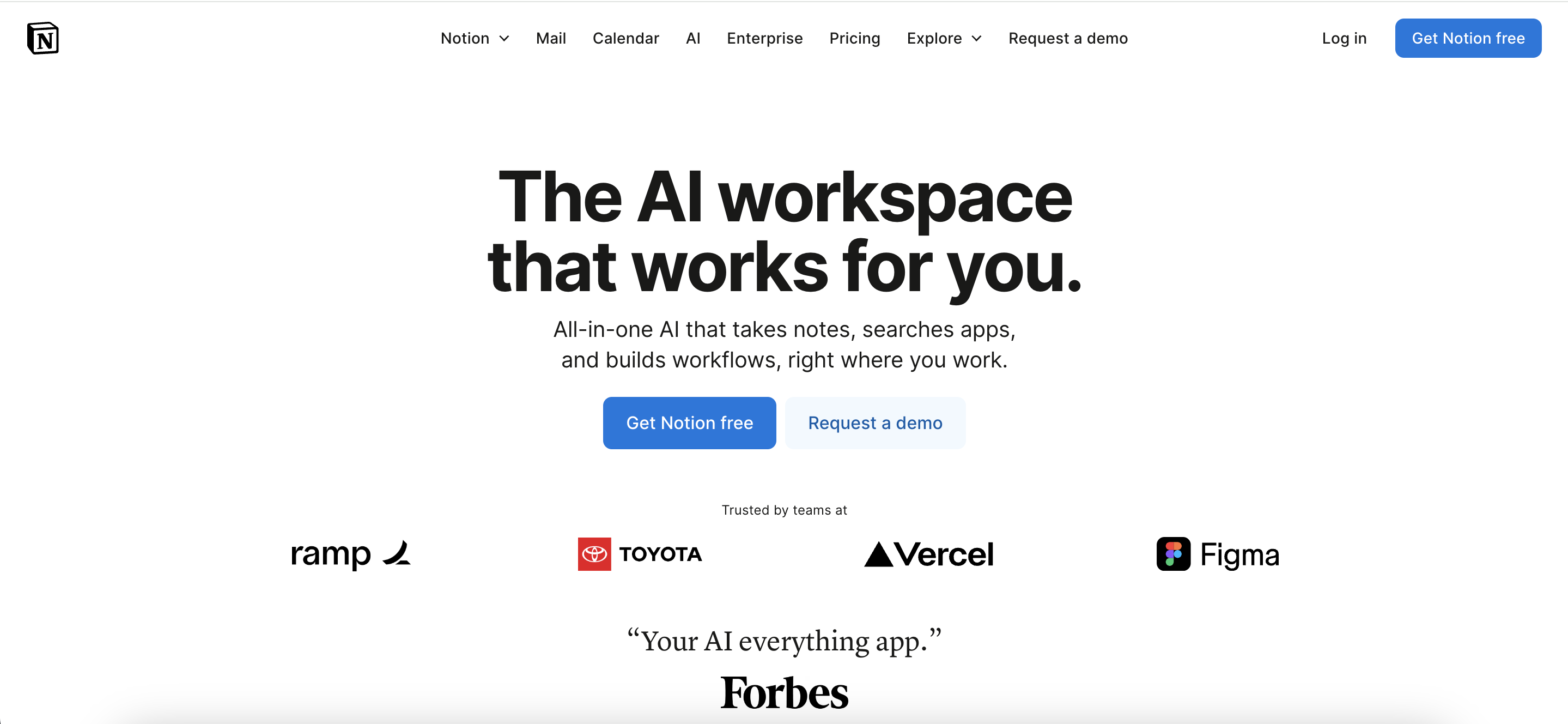
The AI processes and summarises text from research notes, meeting minutes, or uploaded literature. It generates concise overviews of long passages and extracts main ideas from academic content. The system answers user questions by searching through stored notes and documents, providing relevant information based on previous entries.
Notion AI offers database templates designed for academic workflows:
- Literature review templates: Fields for citation details, summaries, and key findings
- Data collection templates: Record variables, sources, and results
- Research planning templates: Structure timelines, objectives, and progress trackers
Each template can be customised to meet the requirements of a specific research process.
Integrating tools with reference managers and libraries
Best AI tools for students often work together with reference managers and digital research libraries. This setup helps researchers organise sources and manage citations more efficiently. Many tools support direct or indirect connections to widely used academic platforms.
Zotero and Mendeley are reference management systems that collect, organise, and cite academic sources. Both platforms have integration options with AI productivity tools. Some document collaboration platforms and note-taking apps allow users to export references in formats compatible with these reference managers. Browser plugins and word processor add-ons let users insert citations and bibliographies into research documents.
Zendy's AI-powered research library works alongside productivity and reference management tools. Users can discover and access full-text articles through Zendy, then export citations to reference managers. Zendy's platform supports AI summarisation, key phrase highlighting, and organised reading lists, which streamline literature reviews and project planning. When used with collaborative writing or task management tools, Zendy provides a central source for reliable academic content and citation data.
Choosing the right tool mix for your research
Selecting AI productivity tools for students and research involves matching tool features to specific project requirements. The best combination depends on research objectives, group size, and preferred working methods. Each tool offers different functions, so understanding your workflow is the first step.
Assessment criteria include research type, collaboration needs, and technical requirements. Qualitative research involving interviews and discussions often uses transcription tools like Otter.AI, while quantitative projects may focus on organisation and project management. Research conducted in teams benefits from document collaboration platforms that support shared editing and centralised knowledge.
Technical requirements include compatibility with institutional systems, device support, integration with reference managers, and data privacy standards. Consider whether the tool works on preferred devices and integrates with other software used for citations or data storage.
Many AI productivity tools offer free versions with core features suitable for individual students or small projects. Larger teams or advanced projects may use paid plans that unlock collaboration, automation, or additional storage. Institutional licenses sometimes provide access to premium features at no individual cost.
Implementation tips for secure compliant use
Academic and institutional environments require careful management of data privacy and security when using AI productivity tools. Each tool interacts with research data differently, so understanding how information is handled protects both individual and institutional interests.
GDPR compliance applies to any tool that processes or stores personal information of individuals in the European Union. Institutional data policies often include guidelines on where research data may be stored, who can access it, and how long it can be retained. Secure handling involves using encrypted connections, selecting tools with end-to-end encryption, and ensuring sensitive files are shared only within approved platforms.
Introducing AI tools to research teams involves several steps:
- Testing phase: Select a small group to test the tool and provide feedback
- Documentation: Create clear guidelines for using tools within research workflows
- Training: Help team members understand secure and responsible usage
- Role establishment: Set up administrators, data managers, and regular users
- Regular reviews: Assess whether tools continue to meet privacy requirements
Discover Zendy for limitless research access
Zendy, AI AI-powered research library, acts as a central research hub that connects with AI productivity tools used in academic work. The platform provides access to scholarly articles, journals, and academic resources across disciplines.
Features such as ZAIA, AI assistant for research, AI-powered summarisation, key phrase highlighting, and organised reading lists help manage literature and support research projects. You can export citations to reference managers and create structured workflows for academic tasks.
For researchers looking to integrate comprehensive literature access with their productivity workflow, Zendy's AI-powered research library provides the foundation for efficient academic research.
FAQs about AI productivity tools for students and researchers
How do AI transcription tools handle sensitive interview recordings?
Most AI productivity tools use encryption and privacy controls to protect sensitive recordings. Researchers need to verify compliance with institutional data policies and obtain participant consent when managing such data.
Can Otter AI transcribe interviews without internet connection?
Otter.AI requires internet connection for real-time transcription. Some features work offline with limited functionality, but full transcription capabilities need online access for processing.
Which productivity tool works best with Zotero and Mendeley?
Notion provides flexible integration through its API, allowing various connections with citation management software. Bit.ai offers direct export features for popular reference managers like Zotero and Mendeley.
Do these AI tools support research content in languages other than English?
Language support varies by tool. Otter AI includes multiple language transcription capabilities, while Notion AI processes text in various languages for research content management.

From Curator to Digital Navigator: Evolving Roles for Modern Librarians
With the growing integration of digital technologies in academia, librarians are becoming facilitators of discovery. They play a vital role in helping students and researchers find credible information, use digital tools effectively, and develop essential research skills. At Zendy, we believe this shift represents a new chapter for librarians, one where they act as mentors, digital strategists, and AI collaborators. Zendy’s AI-powered research assistant, ZAIA, is one example of how librarians can enhance their work using technology. Librarians can utilise ZAIA to assist users in clarifying research questions, discovering relevant papers more efficiently, and understanding complex academic concepts in simpler terms. This partnership between human expertise and AI efficiency allows librarians to focus more on supporting critical thinking, rather than manual searching. According to our latest survey, AI in Education for Students and Researchers: 2025 Trends and Statistics, over 70% of students now rely on AI for research. Librarians are adapting to this shift by integrating these technologies into their services, offering guidance on ethical AI use, research accuracy, and digital literacy. However, this evolution also comes with challenges. Librarians must ensure users understand how to evaluate AI-generated content, check for biases, and verify sources. The focus is moving beyond access to information, it’s now about ensuring that information is used responsibly and critically. To support this changing role, here are some tools and practices modern librarians can integrate into their workflows: AI-Enhanced DiscoveryUsing tools like ZAIA to help researchers refine queries and find relevant studies faster. Research Data Management Organising, preserving, and curating datasets for long-term academic use. Ethical AI and Digital Literacy Training Teaching researchers how to verify AI outputs, evaluate bias, and maintain academic integrity. Collaborative Digital Spaces Facilitating research communication through online repositories and discussion platforms. In conclusion, librarians today are more than curators, they are digital navigators shaping how knowledge is accessed, evaluated, and shared. As technology continues to evolve, so will its role in guiding researchers and students through the expanding world of digital information. .wp-block-image img { max-width: 65% !important; margin-left: auto !important; margin-right: auto !important; }

Strategic AI Skills Every Librarian Must Develop
In 2026, librarians who understand how AI works will be better equipped to support students and researchers, organise collections, and help patrons find reliable information faster. Developing a few key AI skills can make everyday tasks easier and open up new ways to serve your community. Why AI Skills Matter for Librarians AI tools that recommend books, manage citations, or answer basic questions are becoming more common. Learning how these tools work helps librarians: Offer smarter, faster search results. Improve cataloguing accuracy. Provide better guidance to researchers and students. Remember, AI isn’t replacing professional judgment; it’s supporting it. Core AI Literacy Foundations Before diving into specific tools, it helps to understand some basic ideas behind AI. Machine Learning Basics:Machine learning means teaching a computer to recognise patterns in data. In a library setting, this could mean analysing borrowing habits to suggest new titles or resources. Natural Language Processing (NLP):NLP is what allows a chatbot or search tool to understand and respond to human language. It’s how virtual assistants can answer questions like “What are some journals about public health policy?” Quick Terms to Know: Algorithm: A set of steps an AI follows to make a decision. Training Data: The information used to “teach” an AI system. Neural Network: A type of computer model inspired by how the brain processes information. Bias: When data or systems produce unfair or unbalanced results. Metadata Enrichment With AI Cataloguing is one of the areas where AI makes a noticeable difference. Automated Tagging: AI tools can read through titles and abstracts to suggest keywords or subject headings. Knowledge Graphs: These connect related materials, for example, linking a book on climate change with recent journal articles on the same topic. Bias Checking: Some systems can flag outdated or biased terminology in subject classifications. Generative Prompt Skills Knowing how to “talk” to AI tools is a skill in itself. The clearer your request, the better the result. Try experimenting with prompts like these: Research Prompt: “List three recent studies on community reading programs and summarise their findings.” Teaching Prompt: “Write a short activity plan for a workshop on evaluating online information sources.” Summary Prompt: “Give me a brief overview of this article’s key arguments and methods.” Adjusting tone or adding detail can change the outcome. It’s about learning how to guide the tool rather than letting it guess. Ethical Data Practices AI tools can be useful, but they also raise questions about privacy and fairness. Librarians have always cared deeply about protecting patron information, and that remains true with AI. Keep personal data anonymous wherever possible. Review AI outputs for signs of bias or misinformation. Encourage clear policies around how data is stored and used. Ethical AI is part of a librarian’s duty to maintain trust and fairness. Automating Everyday Tasks AI can take over some of the small, routine jobs that fill up a librarian’s day. Circulation: Systems can send overdue reminders automatically or manage renewals. Chatbots: Basic questions like “What are the library hours?” can be handled instantly. Collection Management: AI can spot patterns in borrowing data to suggest which books to keep, reorder, or retire. Building Your Learning Path Getting comfortable with AI doesn’t have to mean earning a new degree. Start small: Take short online courses or micro-certifications in AI literacy. Join librarian groups or online forums where people share practical tips. Block out one hour a week to try out a new tool or attend a webinar. A little consistent learning goes a long way. Making AI Affordable Many smaller libraries worry about cost, but not every tool is expensive. Free Tools: Some open-access AI platforms, like Zendy, offer affordable access to research databases and AI-powered features. Shared Purchases: Partnering with other libraries to share licenses can cut costs. Cloud Services: Pay-as-you-go plans mean you only pay for what you actually use. There’s usually a way to experiment with AI without stretching the budget. Showing Impact Once AI tools are in use, it’s important to show their value. Track things like: Time saved on cataloguing or circulation tasks. Patron feedback on new services. How often are AI tools used compared to manual systems? Numbers matter, but so do stories. Sharing examples, like a student who found research faster thanks to a new search feature, can make your case even stronger. And remember, the future of librarianship is about using AI tools in libraries thoughtfully to keep libraries relevant, reliable, and welcoming spaces for everyone. .wp-block-image img { max-width: 75% !important; margin-left: auto !important; margin-right: auto !important; }

Key Considerations for Training Library Teams on New Research Technologies
The integration of Generative AI into academic life appears to be a significant moment for university libraries. As trusted guides in the information ecosystem, librarians are positioned to help researchers explore this new terrain, but this transition requires developing a fresh set of skills. Training your library team on AI-powered research tools could move beyond technical instruction to focus on critical thinking, ethical understanding, and human judgment. Here is a proposed framework for a training program, organised by the new competencies your team might need to explore. Foundational: Understanding Access and Use This initial module establishes a baseline understanding of the technology itself. Accessing the Platform: Teach the technical steps for using the institution's approved AI tools, including authentication, subscription models, and any specific interfaces (e.g., vendor-integrated AI features in academic databases, institutional LLMs, etc.). Core Mechanics: Explain what a Generative AI platform (like a Large Language Model) is and, crucially, what it is not. Cover foundational concepts like: Training Data: Familiarise staff with how to access the institution’s chosen AI tools, noting any specific authentication requirements or limitations tied to vendor-integrated AI features in academic databases. Prompting Basics: Introduce basic prompt engineering, the art of crafting effective, clear queries to get useful outputs. Hallucinations: Directly address the concept of "hallucinations," or factually incorrect/fabricated outputs and citations, and emphasise the need for human verification. Conceptual: Critical Evaluation and Information Management This module focuses on the librarian's core competency: evaluating information in a new context. Locating and Organising: Train staff on how to use AI tools for practical, time-saving tasks, such as: Generating keywords for better traditional database searches. Summarising long articles to quickly grasp the core argument. Identifying common themes across a set of resources. Evaluating Information: This is perhaps the most critical skill. Teach a new layer of critical information literacy: Source Verification: Always cross-check AI-generated citations, summaries, and facts against reliable, academic sources (library databases, peer-reviewed journals). Bias Identification: Examine AI outputs for subtle biases, especially those related to algorithmic bias in the training data, and discuss how to mitigate this when consulting with researchers. Using and Repurposing: Demonstrate how AI-generated material should be treated—as a raw output that must be heavily edited, critiqued, and cited, not as a final product. Social: Communicating with AI as an Interlocutor The quality of AI output is often dependent on the user’s conversational ability. This module suggests treating the AI platform as a possible partner in a dialogue. Advanced Prompt Engineering: Move beyond basic queries to teach techniques for generating nuanced, high-quality results: Assigning the AI a role (such as a 'sceptical editor' or 'historical analyst') to potentially shape a more nuanced response. Practising iterative conversation, where librarians refine an output by providing feedback and further instructions, treating the interaction as an ongoing intellectual exchange. Shared Understanding: Practise using the platform to help users frame their research questions more effectively. Librarians can guide researchers in using the AI to clarify a vague topic or map out a conceptual framework, turning the tool into a catalyst for deeper thought rather than a final answer generator. Socio-Emotional Awareness: Recognising Impact and Building Confidence This module addresses the human factor, building resilience and confidence Recognising the Impact of Emotions: Acknowledge the possibility of emotional responses, such as uncertainty about shifting professional roles or discomfort with rapid technological change, and facilitate a safe space for dialogue. Knowing Strengths and Weaknesses: Reinforce the unique, human-centric value of the librarian: critical thinking, contextualising information, ethical judgment, and deep disciplinary knowledge, skills that AI cannot replicate. The AI could be seen as a means to automate lower-level tasks, allowing librarians to focus on high-value consultation. Developing Confidence: Implement hands-on, low-stakes practice sessions using real-world research scenarios. Confidence grows from successful interaction, not just theoretical knowledge. Encourage experimentation and a "fail-forward" mentality. Ethical: Acting Ethically as a Digital Citizen Ethical use is the cornerstone of responsible AI adoption in academia. Librarians must be the primary educators on responsible usage. Transparency and Disclosure: Discuss the importance of transparency when utilizing AI. Review institutional and journal guidelines that may require students and faculty to disclose how and when AI was used in their work, and offer guidance on how to properly cite these tools. Data Privacy and Security: Review the potential risks associated with uploading unpublished, proprietary, or personally identifiable information (PII) to public AI services. Establish and enforce clear library policies on what data should never be shared with external tools. Copyright and Intellectual Property (IP): Discuss the murky legal landscape of AI-generated content and IP. Emphasise that AI models are often trained on copyrighted material and that users are responsible for ensuring their outputs do not infringe on existing copyrights. Advocate for using library-licensed, trusted-source AI tools whenever possible. Combating Misinformation: Position the librarian as the essential arbiter against the spread of AI-generated misinformation. Training should include spotting common AI red flags, teaching users how to think sceptically, and promoting the library’s curated, authoritative resources as the gold standard. .wp-block-image img { max-width: 65% !important; margin-left: auto !important; margin-right: auto !important; }
Address
John Eccles HouseRobert Robinson Avenue,
Oxford Science Park, Oxford
OX4 4GP, United Kingdom
